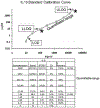Multiplex assays for biomarker research and clinical application: translational science coming of age
- PMID: 21137048
- PMCID: PMC12248403
- DOI: 10.1002/prca.200900217
Multiplex assays for biomarker research and clinical application: translational science coming of age
Abstract
Over the last decade, translational science has come into the focus of academic medicine, and significant intellectual and financial efforts have been made to initiate a multitude of bench-to-bedside projects. The quest for suitable biomarkers that will significantly change clinical practice has become one of the biggest challenges in translational medicine. Quantitative measurement of proteins is a critical step in biomarker discovery. Assessing a large number of potential protein biomarkers in a statistically significant number of samples and controls still constitutes a major technical hurdle. Multiplexed analysis offers significant advantages regarding time, reagent cost, sample requirements and the amount of data that can be generated. The two contemporary approaches in multiplexed and quantitative biomarker validation, antibody-based immunoassays and MS-based multiple (or selected) reaction monitoring, are based on different assay principles and instrument requirements. Both approaches have their own advantages and disadvantages and therefore have complementary roles in the multi-staged biomarker verification and validation process. In this review, we discuss quantitative immunoassay and multiple reaction monitoring/selected reaction monitoring assay principles and development. We also discuss choosing an appropriate platform, judging the performance of assays, obtaining reliable, quantitative results for translational research and clinical applications in the biomarker field.
Copyright © 2010 WILEY-VCH Verlag GmbH & Co. KGaA, Weinheim.
Conflict of interest statement
The authors have declared no conflict of interests.
Figures





Similar articles
-
The Black Book of Psychotropic Dosing and Monitoring.Psychopharmacol Bull. 2024 Jul 8;54(3):8-59. Psychopharmacol Bull. 2024. PMID: 38993656 Free PMC article. Review.
-
Short-Term Memory Impairment.2024 Jun 8. In: StatPearls [Internet]. Treasure Island (FL): StatPearls Publishing; 2025 Jan–. 2024 Jun 8. In: StatPearls [Internet]. Treasure Island (FL): StatPearls Publishing; 2025 Jan–. PMID: 31424720 Free Books & Documents.
-
The use of Open Dialogue in Trauma Informed Care services for mental health consumers and their family networks: A scoping review.J Psychiatr Ment Health Nurs. 2024 Aug;31(4):681-698. doi: 10.1111/jpm.13023. Epub 2024 Jan 17. J Psychiatr Ment Health Nurs. 2024. PMID: 38230967
-
Assessing the comparative effects of interventions in COPD: a tutorial on network meta-analysis for clinicians.Respir Res. 2024 Dec 21;25(1):438. doi: 10.1186/s12931-024-03056-x. Respir Res. 2024. PMID: 39709425 Free PMC article. Review.
-
Uncommon Non-MS Demyelinating Disorders of the Central Nervous System.Curr Neurol Neurosci Rep. 2025 Jul 1;25(1):45. doi: 10.1007/s11910-025-01432-8. Curr Neurol Neurosci Rep. 2025. PMID: 40591029 Review.
Cited by
-
Mass spectrometry assays of plasma biomarkers to predict radiographic progression of knee osteoarthritis.Arthritis Res Ther. 2014 Oct 7;16(5):456. doi: 10.1186/s13075-014-0456-6. Arthritis Res Ther. 2014. PMID: 25287745 Free PMC article.
-
Application of cancer-associated glycoforms and glycan-binding probes to an in vitro diagnostic multivariate index assay for precise diagnoses of cancer.Proteomics. 2016 Dec;16(24):3062-3072. doi: 10.1002/pmic.201500553. Epub 2016 May 11. Proteomics. 2016. PMID: 27005968 Free PMC article. Review.
-
Recent Progress in the Development of Diagnostic Tests for Malaria.Diagnostics (Basel). 2017 Sep 19;7(3):54. doi: 10.3390/diagnostics7030054. Diagnostics (Basel). 2017. PMID: 28925968 Free PMC article. Review.
-
A twist on quantification: measuring the site occupancy of S-nitrosylation.Circ Res. 2012 Oct 26;111(10):1253-5. doi: 10.1161/CIRCRESAHA.112.278721. Circ Res. 2012. PMID: 23104874 Free PMC article. No abstract available.
-
Interlaboratory reproducibility of selective reaction monitoring assays using multiple upfront analyte enrichment strategies.J Proteome Res. 2012 Aug 3;11(8):3986-95. doi: 10.1021/pr300014s. Epub 2012 Jul 3. J Proteome Res. 2012. PMID: 22639787 Free PMC article.
References
-
- Barrett JC, Bennett LM, Fleming LK, Linehan WM et al. , Linking laboratory and clinical research: the development of molecularly targeted therapeutics inside the national cancer institute center for cancer research. Clin. Adv. Hematol. Oncol 2003, 1, 302–306. - PubMed
-
- Pollock BG, Biomarkers: from bedside to bench and back again. Am. J. Geriatr. Psychiatry 2002, 10, 644–645. - PubMed
Publication types
MeSH terms
Substances
Grants and funding
- P50 HL084946/HL/NHLBI NIH HHS/United States
- 5T15HL086386-04/HL/NHLBI NIH HHS/United States
- 1 P50 HL 084,946-01/HL/NHLBI NIH HHS/United States
- 1 RC1 HL100021-01/HL/NHLBI NIH HHS/United States
- 5K12HL087169-04/HL/NHLBI NIH HHS/United States
- RC1 HL100021/HL/NHLBI NIH HHS/United States
- 1U54RR023561-01A1/RR/NCRR NIH HHS/United States
- T15 HL086386/HL/NHLBI NIH HHS/United States
- N01 HV028180/HV/NHLBI NIH HHS/United States
- U54 NS091046/NS/NINDS NIH HHS/United States
- N01-HV-28,120/HV/NHLBI NIH HHS/United States
- K12 HL087169/HL/NHLBI NIH HHS/United States
LinkOut - more resources
Full Text Sources
Other Literature Sources

